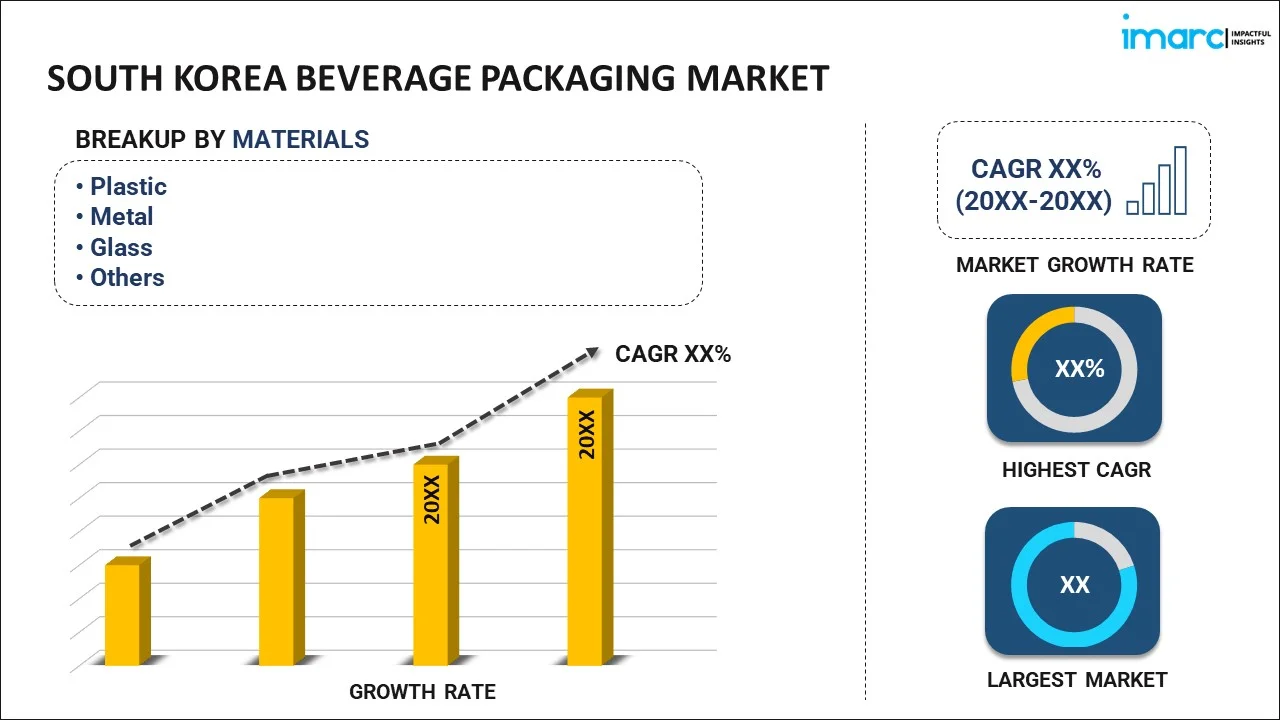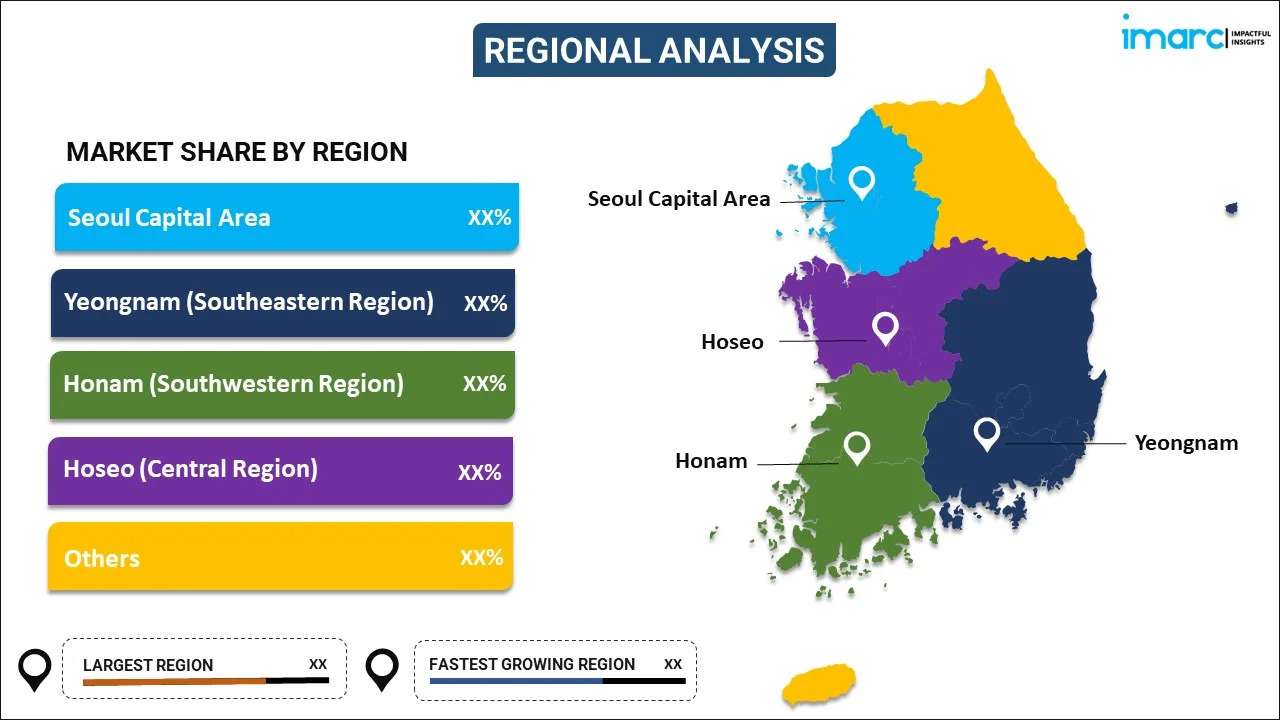
South Korea Beverage Packaging Market Report by Material (Plastic, Metal, Glass, Paperboard, and Others), Product (Bottles, Cans, Pouches, Cartons, and Others), Application (Alcoholic Beverages, Non-Alcoholic Beverages), and Region 2025-2033
Market Overview:
South Korea beverage packaging market size reached USD 3,340.9 Million in 2024. Looking forward, IMARC Group expects the market to reach USD 4,808.9 Million by 2033, exhibiting a growth rate (CAGR) of 4.13% during 2025-2033. The growing demand for sustainable packaging solutions made from biodegradable plastics, compostable materials, and recyclable elements, rising integration of smart packaging technologies, and increasing adoption of durable packaging by e-commerce beverage companies represent some of the key factors driving the market.
|
Report Attribute
|
Key Statistics
|
|---|---|
|
Base Year
|
2024 |
|
Forecast Years
|
2025-2033
|
|
Historical Years
|
2019-2024
|
| Market Size in 2024 | USD 3,340.9 Million |
| Market Forecast in 2033 | USD 4,808.9 Million |
| Market Growth Rate (2025-2033) | 4.13% |
Beverage packaging is employed to encase and present liquid consumables, ranging from water and juices to soft drinks and alcoholic beverages. It comprises bottles and cans, which are made from aluminum and steel, are lightweight in nature, and can preserve carbonation. It also encompasses pouches, which are popular for their lightweight and space-saving advantages, particularly for products like fruit juices and energy drinks. It can be made from a variety of materials, such as glass, plastic, metal, and cartons. It serves as a potential marketing tool, with design and branding playing a pivotal role. It can enhance brand recognition, attract consumers, and communicate essential product information. It must meet functional requirements, such as ease of opening, pouring, and reclosing. It is often integrated with innovative components like resealable caps, ergonomic handles, and pour spouts to enhance the overall user experience. It helps to protect the beverage from external elements that could compromise quality, taste, and safety. It must adhere to various regulations and standards to ensure the safety and legality of the product.
South Korea Beverage Packaging Market Trends:
At present, the increasing demand for sustainable beverage packaging solutions made from biodegradable plastics, compostable materials, and recyclable elements represents one of the crucial factors impelling the growth of the market in South Korea. Individuals are also prioritizing eco-friendly choices, prompting beverage companies to adopt materials and designs that minimize environmental impact. Besides this, the integration of smart packaging technologies is contributing to the market growth. Advanced technologies, such as quick response (QR) codes, Near Field Communication (NFC), and Radio-Frequency Identification (RFID), are being incorporated into packaging to enhance consumer engagement, provide product information, and enable traceability. This not only serves marketing and branding purposes but also contributes to supply chain efficiency by facilitating real-time monitoring of inventory and product movements. In addition, single-serve and on-the-go packaging formats are gaining traction, catering to the fast-paced lives of people who seek convenience without compromising product quality. Innovations like resealable caps, easy-to-carry pouches, and compact designs are becoming pivotal in shaping preferences and driving market growth. Additionally, key market players are investing in customizable packaging to establish a unique identity and foster a deeper connection with consumers. Personalized labels, packaging graphics, and even interactive elements on the packaging are being leveraged to create a more memorable and individualized consumer experience. Moreover, the increasing adoption of durable packaging by e-commerce beverage companies to protect the product during transit and provide a positive unboxing experience is bolstering the market growth.
South Korea Beverage Packaging Market Segmentation:
IMARC Group provides an analysis of the key trends in each segment of the market, along with forecasts at the country levels for 2025-2033. Our report has categorized the market based on material, product, and application.
Material Insights:

- Plastic
- Metal
- Glass
- Paperboard
- Others
The report has provided a detailed breakup and analysis of the market based on the material. This includes plastic, metal, glass, paperboard, and others.
Product Insights:
- Bottles
- Cans
- Pouches
- Cartons
- Others
A detailed breakup and analysis of the market based on the product have also been provided in the report. This includes bottles, cans, pouches, cartons, and others.
Application Insights:
- Alcoholic Beverages
- Non-Alcoholic Beverages
- Carbonated Drinks
- Bottled Water
- Milk
- Fruit and Vegetable Juices
- Energy Drinks
- Plant-Based Drinks
- Others
The report has provided a detailed breakup and analysis of the market based on the application. This includes alcoholic beverages and non-alcoholic beverages (carbonated drinks, bottled water, milk, fruit and vegetable juices, energy drinks, plant-based drinks, and others).
Regional Insights:

- Seoul Capital Area
- Yeongnam (Southeastern Region)
- Honam (Southwestern Region)
- Hoseo (Central Region)
- Others
The report has also provided a comprehensive analysis of all the major regional markets, which include Seoul Capital Area, Yeongnam (Southeastern Region), Honam (Southwestern Region), Hoseo (Central Region), and others.
Competitive Landscape:
The market research report has also provided a comprehensive analysis of the competitive landscape in the market. Competitive analysis such as market structure, key player positioning, top winning strategies, competitive dashboard, and company evaluation quadrant has been covered in the report. Also, detailed profiles of all major companies have been provided.
South Korea Beverage Packaging Market Report Coverage:
| Report Features | Details |
|---|---|
| Base Year of the Analysis | 2024 |
| Historical Period | 2019-2024 |
| Forecast Period | 2025-2033 |
| Units | Million USD |
| Scope of the Report | Exploration of Historical and Forecast Trends, Industry Catalysts and Challenges, Segment-Wise Historical and Predictive Market Assessment:
|
| Materials Covered | Plastic, Metal, Glass, Paperboard, Others |
| Products Covered | Bottles, Cans, Pouches, Cartons, Others |
| Applications Covered |
|
| Regions Covered | Seoul Capital Area, Yeongnam (Southeastern Region), Honam (Southwestern Region), Hoseo (Central Region), Others |
| Customization Scope | 10% Free Customization |
| Post-Sale Analyst Support | 10-12 Weeks |
| Delivery Format | PDF and Excel through Email (We can also provide the editable version of the report in PPT/Word format on special request) |
Key Questions Answered in This Report:
- How has the South Korea beverage packaging market performed so far and how will it perform in the coming years?
- What is the breakup of the South Korea beverage packaging market on the basis of material?
- What is the breakup of the South Korea beverage packaging market on the basis of product?
- What is the breakup of the South Korea beverage packaging market on the basis of application?
- What are the various stages in the value chain of the South Korea beverage packaging market?
- What are the key driving factors and challenges in the South Korea beverage packaging?
- What is the structure of the South Korea beverage packaging market and who are the key players?
- What is the degree of competition in the South Korea beverage packaging market?
Key Benefits for Stakeholders:
- IMARC’s industry report offers a comprehensive quantitative analysis of various market segments, historical and current market trends, market forecasts, and dynamics of the South Korea beverage packaging market from 2019-2033.
- The research report provides the latest information on the market drivers, challenges, and opportunities in the South Korea beverage packaging market.
- Porter's five forces analysis assist stakeholders in assessing the impact of new entrants, competitive rivalry, supplier power, buyer power, and the threat of substitution. It helps stakeholders to analyze the level of competition within the South Korea beverage packaging industry and its attractiveness.
- Competitive landscape allows stakeholders to understand their competitive environment and provides an insight into the current positions of key players in the market.
Need more help?
- Speak to our experienced analysts for insights on the current market scenarios.
- Include additional segments and countries to customize the report as per your requirement.
- Gain an unparalleled competitive advantage in your domain by understanding how to utilize the report and positively impacting your operations and revenue.
- For further assistance, please connect with our analysts.
 Request Customization
Request Customization
 Speak to an Analyst
Speak to an Analyst
 Request Brochure
Request Brochure
 Inquire Before Buying
Inquire Before Buying




.webp)




.webp)












